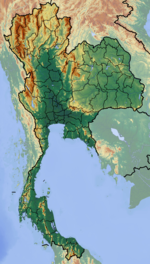Ny Wang or Nü-wang (Chinese: 女王[1]: 193 ) was an ancient political entity mentions in the Chinese records in the late 9th and 13th centuries, located in either the central Mekong valley of Laos and Thailand[1]: 144 or northern Thailand.[2]: 166–67 It was said to be ruled by the queen[1]: 144 [2]: 166–67 and possibly is of the Austric-speaking people as matriarchal regimes certainly existed.[1]: 144 In the Chinese record Man-chu 蛮书 written by Fán chuò 樊绰, the kingdom was attacked by 20,000 Man people but won.[1]: 143 [2]: 167 The Man (蠻) is non-Chinese peoples in southern China throughout history, which considered barbarian.[2]: 167 [3] In this case, probably was the troop of Nanzhao.[2]: 167
Ny Wang Kingdom | |
|---|---|
| c. 9th – late 13th century | |
Location of Ny Wang cursorily speculated by Gordon Luce | |
| Common languages | Austric |
| Government | Monarchy |
| Historical era | Post-classical era |
• First mentioned in Chinese record | 9th century |
• Send tribute to China | 1289 |
Ny Wang joined Lavo Kingdom in sending an embassy to the Yuan dynasty during the reign of Kublai Khan in 1289.[1]: 144 This make Thai academics hypothesize that Ny Wang was possibly the Haripuñjaya kingdom, whose ruled by the Lavo's princess, Jamadevi, in the beginning of the establishment,[4][5]: 132 whereas Gordon Luce speculates that Haripuñjaya was probably K'un-lun mentions in the Man-chu.[1]: 143–44
Location
editIts exact location remains unclear. According to the details given in the Chinese record, Ny Wang is 10-day stages far from the west of Huan-chou near the present-Hà Tĩnh in Vietnam, and over 30 stages from the Chên-nan chieh-tu on the Man's Nanzhao border, possibly in present central Yunnan.[1]: 143 [2]: 166 Its border meets Chenla in the south.[1]: 144 Gordon Luce speculates that it is probably located in the middle Mekong Valley at the great bend east of Vieng Chan.[1]: 144
References
edit- ^ a b c d e f g h i j Luce, G.H. (1958). "The Early Syam in Burma's History" (PDF). Journal of the Siam Society. 46: 123–213. Retrieved 8 November 2024.
- ^ a b c d e f Kanokporn Numtong (2020). "หลักฐานล้านนาในเอกสารโบราณจีน: บันทึกเกี่ยวกับอาณาจักรสนมแปดร้อยในพงศาวดารหมาน พงศาวดารราชวงศ์หยวน พงศาวดารราชวงศ์หยวนฉบับใหม่และเจาปู๋จ่งลู่" [Evidence of Lanna Kingdom in Ancient Chinese manuscripts: Records of Eight Concubine Kingdom in Man Chronicle, Yuan Chronicle, Modern Yuan Chronicle and Zhaobu Zonglu]. Chinese Studies Journal (in Thai). p. 157–227.
- ^ "Man 蠻". www.chinaknowledge.de. 18 January 2013. Retrieved 8 November 2024.
- ^ Chanan Yodhong (10 October 2017). "ผู้หญิงกับการเมืองล้านนา ก่อน 'รากนครา'" [Women and Lanna Politics Before 'Rak Nakorn']. thematter.co (in Thai). Retrieved 9 November 2024.
- ^ Pajaree Onsa-ard (2016). "ตามรอยตำนาน "พระนางจามเทวี" ผ่านพัฒนาการสื่อ" [Tracing the Legend of “Queen Chamathewi” through Media Development.]. Dhuraku Pundit Communication Arts Journal (in Thai). 10 (2).
